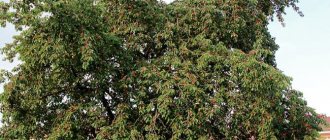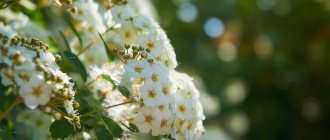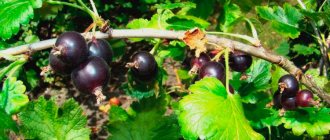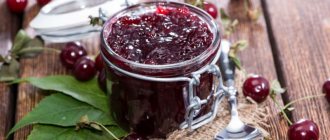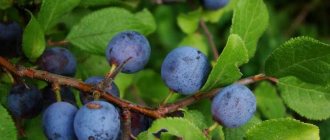Cherry is one of the most popular stone fruit crops. Currently, more than 1.5 thousand varieties are known, but no more than 100 are cultivated in amateur and industrial gardens. Only the best varieties of cherries, which have a complex of valuable properties - good taste of the fruit, disease resistance, frost resistance, moderate growth, are widely used. We will talk about some of them in this article.
Some gardeners grow ancient varieties of folk selection, others prefer modern innovations
Landing site: basic requirements for the site
An important limitation for planting cherries is the site’s tendency to stagnate moisture. The tree is not planted in lowlands, near groundwater, where the soil is prone to rapid waterlogging.
Excessive moisture has a negative impact on the condition of tree roots. They overheat, rot, and become infected with diseases. The tree dries out and the cherry blossoms do not bloom in a timely manner.
The ideal choice for placing cherries is:
- well-lit areas with a southern, western, southwestern location;
- plain or hill, sheltered from intense winds;
- sandy, loamy soil with good drainage;
- absence of excessive soil acidity.
If the acidity level is increased, liming will help. After this procedure, it is recommended to saturate the soil with compost or fertilize with mullein. Then the area is dug up.
conclusions
- In horticulture, there is a whole range of varieties of cherry trees. The basic principles of classification are based on tree type, ripening time, growing regions, and decorative characteristics.
- Most cherry varieties bear fruit normally only if pollinators are present.
- The Urals and Siberia require frost-resistant crop varieties.
- Decorative cherries are widely used in landscape design and produce good fruits.
Also read about the best 12 varieties of self-fertile cherries for the Middle Zone.
Planting material: preparation secrets
The most favorable time for planting cherries is autumn. This applies to harvesting shoots and rooting. When selecting planting material yourself, you should separate several green shoots located on the southern part of the tree. Cuttings are cut from them, having at least 4 leaves, approximately 12 cm long.
Harvested seedlings are placed in a container with soil at a distance of 6-7 cm from each other. Creating a “greenhouse effect” will significantly speed up the rooting process. To do this, the box with the planted cuttings is covered with polyethylene. Until spring, seedlings should be provided with conditions for wintering: buried, covered with spruce branches.
When choosing ready-made trees as planting material, you should pay attention to two-year-old seedlings. The parameters of such plants are as follows:
- 55–60 cm - height;
- 56–60 cm — length of skeletal shoots;
- 2 cm is the diameter of the tree.
Such seedlings are most suitable for autumn planting for wintering. It is recommended to place trees in open ground in the spring.
Advantages and disadvantages
The main advantages of dwarf trees compared to tall ones are:
- Easier harvesting and maintenance.
- Rapid growth and development, early harvest.
- The culture's high cold resistance allows the plant to overwinter without the need to build a shelter in most regions.
- Availability of cultivation both on individual farms and on an industrial scale.
- Fruiting quality.
- Compactness of the plant.
- The plant is undemanding to the growing soil.
- Abundance of harvest.
- Resistant to wind and drafts.
- Good and quick adaptation to a new place of growth.
- Versatility of use.
The main disadvantages are the taste of the fruit (there is sourness) and their small size. However, due to everyone’s personal preferences, many gardeners will be able to name these criteria as strengths.
Also, due to the lack of pollinators nearby, there may be a decrease in yield.
Fertilizing cherries: subtleties of organizing the process
Caring for cherries begins with preparing the substrate for planting. It is pre-enriched with nutritional components through fertilizer. Preparation of the planting site begins in the fall.
The sequence of actions is as follows:
- the soil is treated with dolomite flour or limestone (400 g/sq.m);
- dig up the soil to the depth of a spade bayonet;
- a week after digging, add mature manure (15 kg/sq.m);
- In the spring, when planting trees, the top fertile layer is removed and supplemented with humus, as well as ash, superphosphate, and potassium chloride (1 kg/30–40 g/25 g, respectively).
Such preparation is optimal for effective rooting and growth of the plant in open ground. Over the next 2-3 years, the tree does not require feeding. After this period, in order for the color of ripe cherries to please regularly, the plant is fertilized.
In the fall, compounds based on potassium and phosphorus are added, in the spring - nitrogen. The beginning of the growing season is marked by the use of organic fertilizing, which is done twice (at the end of flowering, 2 weeks after that).
Reviews from gardeners
Oleg, 45 years old, Moscow region
I recently planted Molodezhnaya in my dacha. This cherry pleased me with both the small size of the tree and the large tasty berries. At 4 years old, its height is less than two meters, the branches are slightly drooping, so it is very convenient to care for it and harvest. The tree does not need pollinators, the harvest is already good, and it also pollinates Vladimirskaya, which I also really like.
Yana, 42 years old, Klin
I am very pleased with the Chocolate Girl. The tree is beautiful and low. The berries are almost black, very tasty, sweet. We harvest every year, even if the spring is cold. To prevent the tree from getting sick, I spray it with fungicides before the buds open.
Veronica, 53 years old, Rostov region
Shpanka has been growing in our garden for many years and every year it pleases us with a bountiful harvest and is not afraid of drought, heat or frost. The berries are large, sweet, with light yellow, very juicy pulp. We eat them fresh, make compotes and jam. The tree is quite tall, so that it does not grow too much, the crown needs to be shaped. In addition to pruning, it is also necessary to regularly treat with Bordeaux mixture.
Landing: important rules
In the spring, after waiting for warmer weather, successfully overwintered cuttings are moved to open ground. To do this, prepare holes about half a meter deep and in diameter. Proceed as follows:
- carefully study the condition of the roots (weak and damaged ones are removed);
- a few hours before planting (2-5), the seedlings are immersed in warm water;
- the bottom of the planting pit is supplemented with a cone-shaped earthen ball;
- the seedling is placed on top of the formed mound, the roots are well straightened;
- when filling the hole, the plant is lifted upward (the scion should be 2-3 cm above ground level);
- the soil around the trunk is compacted and a fill is formed (within a radius of 25-30 cm);
- the resulting depression behind the roller, intended for irrigation, is filled with 2-3 buckets of settled water;
- the planting site is mulched (sprinkled with sawdust or humus);
- create additional support for the trunk (tied to a support peg).
It is important to remember that when planting tree varieties of cherries, a distance of 3-3.5 m should be maintained, and bush varieties - 2-2.5 m.
In order not to be mistaken in the intricacies of planting and care, it is better to first familiarize yourself with a detailed description of the cherry varieties used in the work.
10 best frost-resistant peach varietiesWinter-hardy varieties of apricots: the best, tasty, frost-resistant varieties
How to plant trees in the fall: timing, planting stages and varieties
Pantry of vitamins
Cherries contain a large number of various vitamins that are very beneficial for human health.
Cherries even have healing properties. Cherries are especially rich in vitamins A, C and B, which allows them to fight colds well.
Cherries also contain many amino acids, including folic acid, which is very useful in the nutrition of pregnant women.
Cherry berries contain a lot of potassium, calcium, magnesium, phosphorus, but its main remarkable advantage is that it contains a high content of antioxidants, useful for the health of the human body.
Eating cherries is beneficial for people with heart and vascular diseases. Along with cherries, iron enters our body, which is beneficial for people with anemia.
Due to the fact that the berries contain a lot of organic acids, they are recommended for those who suffer from gastritis with low acidity.
Cherry concentrates are included in many medicines. Since cherries are so common and accessible, people use the abundance of beneficial substances in them for use in traditional medicine recipes.
Infusions and decoctions are prepared from fruits, leaves, stalks, and tree bark, which are used in the form of drinks, compresses and baths.
But it is important to remember that traditional methods of treatment can only be used with the approval of a doctor, since they can be a good addition to treatment with medications, but a replacement for them.
In addition to being used for treatment and healing, cherries have found their use in cosmetology. Her scents are very popular and are famous in various perfume lines.
Crown formation: stages of an irreplaceable process
The formation of the crown should begin when the tree reaches 1 year. There are different types of branch thinning:
- spring;
- autumn;
- regular.
The most important process occurs after wintering. Work begins long before the start of the growing season - in mid-March. A fresh tree is shortened to 65-80 cm in height. Particular attention is paid to the skeletal branches: 3-4 shoots are left at a distance of 10-15 cm relative to each other.
Over the next 2–3 years, active crown formation occurs. Next, the tree needs careful pruning if the branches grow more than 50 cm in length.
Autumn pruning is done with caution. It is important not to harm the health of the tree, which is about to winter quickly. To do this, it is advisable to choose the right moment: between the end of the growing season and the onset of the first frost. In the fall, it is customary to carry out thorough sanitation: removing weak, diseased shoots.
As part of regular care, all diseased, broken shoots growing inside the crown are removed in a timely manner. This work is carried out throughout the entire summer season. Careful inspection and restoration is the important work of a good gardener.
What work needs to be done in the fall to prepare fruit trees for winterPlanting and replanting trees in autumn: recommendations from experienced gardeners
What are the benefits of pomegranate for health and immunity?
The cherry orchard, beautiful and fruitful, pleases the eye of any owner. Planting and caring for trees require compliance with the rules. And the choice of which cherry is better is always individual.
Botanical description
The common cherry is the most common variety in many countries of the world, because this plant is of great value. Fruits have many useful substances that, especially today, the body of any age needs. These are organic acids, sugars, vitamins, iron and much more.
This cultivated species is a symbiosis of the well-known sweet cherry and steppe cherry.
The tree can reach up to five to six meters in height. Flowers during the period of rapid flowering are characterized by the presence of 5 petals with an average of 15 stamens. The fruit consists of red, cherry-colored pulp (burgundy shades may appear when ripe) and a bone ball inside. This fruit representative has a special taste – sourish-sweet. Growth occurs in moderate temperature zones.
As for the bark, young branches are characterized by reddish-brown shades; older branches and trunk have the same color scheme - gray, with reflections in places.
The leaves have a primitive petiolate shape with a shiny dark green surface on the outside and slightly lighter on the underside. The leaf length is usually between six and eight centimeters.
Cherry blossoms are a decoration for any garden
Classification
Species: Common cherry, Kingdom: Plants Genus: Plum, Division: Flowering, Rose family. In total, there are about 150 different species of this plant with minor differences (mainly taste and species).
Flower formula
The formula for flower formation is as follows: h5 l5 t5 p1
Each value means the following:
- Ch5 - presence of five sepals;
- L5 – five petals;
- T5 – five stamens;
- P1 – one pestle.
Also visible is the correct shape, the presence of several axes of symmetry and the presence of bisexual origin.
Cherry blossoms

